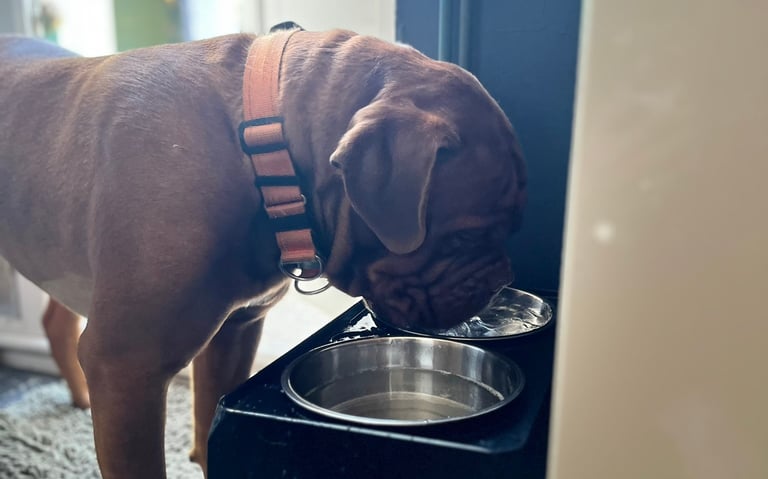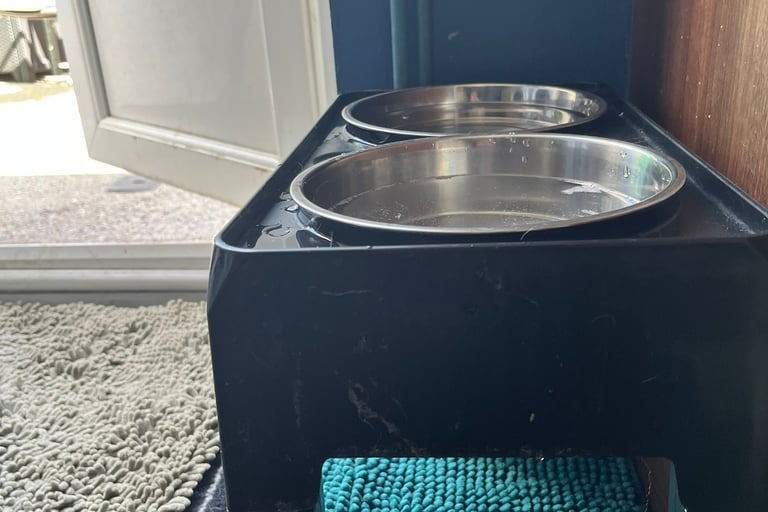Disclosure: Some ads may contain affiliate links. I may earn a commission if you make a purchase, at no extra cost to you.
Should You Use a Raised Feeding Bowl for Your Large Breed Dog? The Surprising Truth About Bloat Risk
Do raised feeding bowls reduce the risk of bloat (GDV) in large breed dogs? Learn what the latest research from the US and Europe really says—and what dog owners should do instead
PET HEALTH
4/20/20255 min read
Should You Use a Raised Feeding Bowl for Your Large Breed Dog? The Surprising Truth About Bloat Risk
If you have a large or giant breed dog, you've probably heard of bloat (also known as gastric dilatation-volvulus, or GDV). It's a serious, life-threatening condition where a dog's stomach fills with gas and can twist, cutting off blood flow. It requires immediate veterinary attention and, unfortunately, can be fatal if not treated quickly.
One long-debated topic in the pet world is whether raised feeding bowls help or hurt when it comes to bloat risk. Some believe that elevated feeders improve posture, digestion, and even reduce bloating, while others argue they might actually increase the risk of GDV.
So, what's the truth? Let’s break down the latest research and find out whether you should keep that raised feeder or switch back to floor-level bowls.
What Causes GDV (Bloat) in Dogs?
Bloat happens when the stomach rapidly fills with gas, causing it to expand. In severe cases, the stomach can twist (volvulus), cutting off blood supply and leading to shock or even death.
Risk Factors for GDV:
According to the American College of Veterinary Surgeons (ACVS), some factors that increase the risk of GDV include:
Breed & Body Type: Deep-chested, large, and giant breeds (e.g., Great Danes, St. Bernards, Weimaraners) are at the highest risk.
Age: Older dogs (7+ years) are more susceptible.
Eating Habits: Dogs that eat quickly or consume large meals in one sitting may be more prone to GDV.
Exercise After Eating: Running or playing immediately after a meal could contribute to stomach bloating.
Stress & Anxiety: Nervous or anxious dogs may have an increased likelihood of developing bloat.
But what about raised feeding bowls? Do they help or hurt?
The Raised Feeding Bowl Debate
Some pet brands promote elevated feeders as a way to reduce strain on a dog’s neck and joints while eating. Others claim that raised bowls help prevent bloating. However, scientific research does not fully support these claims.
In fact, some studies suggest the opposite!
What Does the Research Say?
📌 Study #1: Raised Bowls May Increase Bloat Risk (Glickman et al., 2000)
A large-scale study published in the Journal of the American Veterinary Medical Association (JAVMA) followed 1,637 large and giant breed dogs. It found that using raised feeders was linked to a higher risk of GDV:
Large breeds using raised bowls were twice as likely to develop bloat.
Giant breeds using raised bowls had a 52% increased risk of GDV.
These results contradict the common belief that elevated bowls reduce bloat risk.
📌 Study #2: No Significant Link Found (Pipan et al., 2012)
A separate study published in JAVMA surveyed dog owners about feeding practices and GDV risk. Unlike the previous study, this research did not find a strong connection between raised feeders and bloat.
The authors noted that survey-based studies have limitations, meaning the results should be interpreted cautiously.
It's worth noting this was a self-reported, survey-based study, which can be less reliable than controlled clinical research. The same can be said of the 2020 European research below.
European Research
In a 2019 review, researchers at the University of Edinburgh examined the link between raised feeding bowls and the risk of bloat (gastric dilatation-volvulus, or GDV) in dogs. The review concluded that the evidence is conflicting, but notably, one large study found that feeding from raised bowls may actually increase the risk of GDV in large and giant breed dogs. Based on current findings, feeding from floor-level bowls remains the safest recommendation for at-risk breeds. Read the full study from the University of Edinburgh
A 2020 survey conducted by Simona Normando at the University of Padua in Italy explored the prevalence of raised feeding bowls among Italian dog owners. Out of 715 dogs surveyed, 25.2% were fed from raised bowls. Some owners believed this practice prevented GDV, often based on veterinary advice. However, the study found no significant differences in health issues or undesirable behaviors between dogs fed from raised bowls and those fed from floor-level bowls. The authors concluded that more scientific studies are needed to understand the actual effects of raised feeding bowls on dogs' health .
Spleen Tumors and Their Link to GDV
Although spleen tumors and GDV are not directly related, they can sometimes occur together. The spleen is located near the stomach, and when GDV happens, it can cause the spleen to twist abnormally, leading to damage or even requiring removal.
Interestingly, dogs who have undergone a splenectomy (spleen removal) may have a higher risk of developing GDV compared to those with an intact spleen. While spleen tumors themselves don’t necessarily cause bloat, their presence—and especially their removal—could be a contributing factor.
So… Should You Use a Raised Feeding Bowl?
Given the conflicting research, the safest approach is to err on the side of caution—especially if you have a large or giant breed dog. While the exact cause of GDV isn’t fully understood, we know that raised bowls might increase risk in some dogs.
What You Can Do Instead:
🐶 Feed meals at floor level – There’s no solid evidence that raised bowls provide benefits for most dogs.
🐶 Slow down mealtime – Use slow-feeder bowls or puzzle feeders to prevent gulping air while eating. (Here are some examples available to buy on Amazon UK) #Ad
🐶 Serve smaller, more frequent meals – Instead of one or two big meals, try breaking meals into 3-4 portions.
🐶 Limit post-meal activity – Avoid vigorous play or exercise for at least an hour after eating.
🐶 Consider preventive surgery – A prophylactic gastropexy (learn more) can prevent GDV in high-risk breeds.
Breed-Specific Guidance
The Weimaraner Club of Great Britain advises against the use of raised bowls for breeds prone to bloat, noting that one study found an increased risk of GDV associated with elevated feeding.
Disclaimer
This blog is for informational purposes only and is not a substitute for professional veterinary advice. If you suspect your dog has GDV or any medical emergency, contact a licensed veterinarian immediately.
Final Thoughts
At the end of the day, there’s no one-size-fits-all answer. However, if you have a large or giant breed dog, it may be safest to avoid raised feeding bowls—especially given the risks highlighted in studies.
I had one Bordeaux in particular that would vomit if given two meals a day, she would pace and drool, even though she had a raised feeder and we avoided exercise before and after meals. We broke her meals down into 3 smaller portions a day and this helped her immensely. That experience reminded me how individual every dog is. Instead, focus on slow, mindful eating habits and regular vet check-ups to keep your pup happy and healthy.
Remember to always consult your veterinarian before making changes to your dog’s diet, feeding habits, or if you suspect any health issues.
What do you think? Do you use a raised feeder for your dog?
References
Glickman, L. et al. (2000). Non-dietary risk factors for gastric dilation-volvulus in large and giant breed dogs. Journal of the American Veterinary Medical Association, 217(10), 1492–1499.
Pipan, M. et al. (2012). An internet-based survey of risk factors for surgical gastric dilation-volvulus in dogs. Journal of the American Veterinary Medical Association, 240(12), 1456–1462.
American College of Veterinary Surgeons. Gastric Dilatation-Volvulus.






Disclosure: As an Amazon Associate I earn from Qualifying purchases
©Meo's World
Meo's world
<--Awin verification 001-->
Bark
Fetch
meosworld@yahoo.com
© Meo's World 2025. All rights reserved.
